It's always exciting to find good quality free resources in the internet.
I got this site's address from an email list. It has free math workbooks to download (yes complete workbooks!) for most of the grades, and they're pretty good.
Mathematics Enhancement Programme - School curriculum materials
And, this link has Online mathematics tests for student assessment for grades K-11. Multiple choice.
I also wanted to start making a list of such great free or inexpensive curriculum-related materials. Please click here to see it.. just a start. If you have suggestions, feel free to email me.
Tags: math, curriculum
Anime, movie, comic book, video game, or TV related papercrafts, paper models and paper toys.
Saturday, April 29, 2006
Free math materials
It's always exciting to find good quality free resources in the internet.
I got this site's address from an email list. It has free math workbooks to download (yes complete workbooks!) for most of the grades, and they're pretty good.
Mathematics Enhancement Programme - School curriculum materials
And, this link has Online mathematics tests for student assessment for grades K-11. Multiple choice.
I also wanted to start making a list of such great free or inexpensive curriculum-related materials. Please click here to see it.. just a start. If you have suggestions, feel free to email me.
Tags: math, curriculum
I got this site's address from an email list. It has free math workbooks to download (yes complete workbooks!) for most of the grades, and they're pretty good.
Mathematics Enhancement Programme - School curriculum materials
And, this link has Online mathematics tests for student assessment for grades K-11. Multiple choice.
I also wanted to start making a list of such great free or inexpensive curriculum-related materials. Please click here to see it.. just a start. If you have suggestions, feel free to email me.
Tags: math, curriculum
Wednesday, April 26, 2006
Distributive property
A little bit of math for you today.
Usually kids encounter these words in algebra or maybe pre-algebra. But, they use the principle long before that, say in 2nd or 3rd grade. Did you know where?
The distributive property says (as it's stated in algebra class) that
a (b + c) = ab + ac.
It's true for all real numbers - including negative ones, so it follows it's true for subtraction too:
a (b - c) = ab - ac.
We use this principle often when multiplying numbers. For example, do in your head 7 × 21. Most people take 7 × 20 and 7 × 1 and add those. In other words, you 'broke down' 21 to two parts and multiplied the parts by 7 separately:
7 × (20 + 1) = 7 × 20 + 7 × 1.
How about 8 × 98? Aren't you tempted to go 8 × 100 and subtract 16?
8 × (100 - 2) = 8 × 100 - 8 × 2.
Studying multiplying 2-digit numbers is THE time to talk about this idea in detail.
37
× 4

Here, you should explain that this algorithm (or procedure) is based on the idea that you multiply 4 × 7 and then 4 × 30. In other words,
4 × 37 = 4 × (30 + 7) = 4 × 30 + 4 × 7.
You can even write it out this (unconventional) way, which conveys the basic idea better:
37
× 4

28
+ 120

148
The idea is, of course, exactly the same if you have a 3-digit number. For example:
5 × 487 = 5 × (400 + 80 + 7) = 5 × 400 + 5 × 80 + 5 × 7.
You can again write it out this (unconventional) way, which conveys the basic idea better:
487
× 5

35
400
+ 2000

2435
Or, the conventional way looks like this:
4 3
487
× 5

2435
The idea is STILL the same if you're multiplying 2-digit numbers by 2-digit numbers; you just have more 'parts' in your numbers. For example, 38 × 47. You need to do 30 × 40, 30 × 7, 8 × 40 and 8 × 7, and add all those.
How about writing it out like this for kids:
38
× 47

56
210
320
+ 1200

When you explain WHY it works, and show HOW it works, you are teaching both conceptual knowledge and procedural knowledge.
There is a lot of debate as to which should be taught first. I don't really know; I don't even know if it perhaps varies from child to child. I think this is the way I would do it:
1) Teach why it works - but not expect the student to grasp it totally.
2) Teach how it works and have him practice.
3) Teach again why it works.
4) Again practice how it works.
After going back and forth a few times between the concept and the procedure, hopefully both sink in. Also I would require knowing the 'why' in a test: I would ask the student to explain, in his own words, why it works.
Remember, he's going to need to know it well in algebra.
Tags: math, lesson, algebra
Usually kids encounter these words in algebra or maybe pre-algebra. But, they use the principle long before that, say in 2nd or 3rd grade. Did you know where?
The distributive property says (as it's stated in algebra class) that
a (b + c) = ab + ac.
It's true for all real numbers - including negative ones, so it follows it's true for subtraction too:
a (b - c) = ab - ac.
We use this principle often when multiplying numbers. For example, do in your head 7 × 21. Most people take 7 × 20 and 7 × 1 and add those. In other words, you 'broke down' 21 to two parts and multiplied the parts by 7 separately:
7 × (20 + 1) = 7 × 20 + 7 × 1.
How about 8 × 98? Aren't you tempted to go 8 × 100 and subtract 16?
8 × (100 - 2) = 8 × 100 - 8 × 2.
Studying multiplying 2-digit numbers is THE time to talk about this idea in detail.
37
× 4
Here, you should explain that this algorithm (or procedure) is based on the idea that you multiply 4 × 7 and then 4 × 30. In other words,
4 × 37 = 4 × (30 + 7) = 4 × 30 + 4 × 7.
You can even write it out this (unconventional) way, which conveys the basic idea better:
37
× 4
28
+ 120
148
The idea is, of course, exactly the same if you have a 3-digit number. For example:
5 × 487 = 5 × (400 + 80 + 7) = 5 × 400 + 5 × 80 + 5 × 7.
You can again write it out this (unconventional) way, which conveys the basic idea better:
487
× 5
35
400
+ 2000
2435
Or, the conventional way looks like this:
4 3
487
× 5
2435
The idea is STILL the same if you're multiplying 2-digit numbers by 2-digit numbers; you just have more 'parts' in your numbers. For example, 38 × 47. You need to do 30 × 40, 30 × 7, 8 × 40 and 8 × 7, and add all those.
How about writing it out like this for kids:
38
× 47
56
210
320
+ 1200
When you explain WHY it works, and show HOW it works, you are teaching both conceptual knowledge and procedural knowledge.
There is a lot of debate as to which should be taught first. I don't really know; I don't even know if it perhaps varies from child to child. I think this is the way I would do it:
1) Teach why it works - but not expect the student to grasp it totally.
2) Teach how it works and have him practice.
3) Teach again why it works.
4) Again practice how it works.
After going back and forth a few times between the concept and the procedure, hopefully both sink in. Also I would require knowing the 'why' in a test: I would ask the student to explain, in his own words, why it works.
Remember, he's going to need to know it well in algebra.
Tags: math, lesson, algebra
Distributive property
A little bit of math for you today.
Usually kids encounter these words in algebra or maybe pre-algebra. But, they use the principle long before that, say in 2nd or 3rd grade. Did you know where?
The distributive property says (as it's stated in algebra class) that
a (b + c) = ab + ac.
It's true for all real numbers - including negative ones, so it follows it's true for subtraction too:
a (b - c) = ab - ac.
We use this principle often when multiplying numbers. For example, do in your head 7 × 21. Most people take 7 × 20 and 7 × 1 and add those. In other words, you 'broke down' 21 to two parts and multiplied the parts by 7 separately:
7 × (20 + 1) = 7 × 20 + 7 × 1.
How about 8 × 98? Aren't you tempted to go 8 × 100 and subtract 16?
8 × (100 - 2) = 8 × 100 - 8 × 2.
Studying multiplying 2-digit numbers is THE time to talk about this idea in detail.
37
× 4

Here, you should explain that this algorithm (or procedure) is based on the idea that you multiply 4 × 7 and then 4 × 30. In other words,
4 × 37 = 4 × (30 + 7) = 4 × 30 + 4 × 7.
You can even write it out this (unconventional) way, which conveys the basic idea better:
37
× 4

28
+ 120

148
The idea is, of course, exactly the same if you have a 3-digit number. For example:
5 × 487 = 5 × (400 + 80 + 7) = 5 × 400 + 5 × 80 + 5 × 7.
You can again write it out this (unconventional) way, which conveys the basic idea better:
487
× 5

35
400
+ 2000

2435
Or, the conventional way looks like this:
4 3
487
× 5

2435
The idea is STILL the same if you're multiplying 2-digit numbers by 2-digit numbers; you just have more 'parts' in your numbers. For example, 38 × 47. You need to do 30 × 40, 30 × 7, 8 × 40 and 8 × 7, and add all those.
How about writing it out like this for kids:
38
× 47

56
210
320
+ 1200

When you explain WHY it works, and show HOW it works, you are teaching both conceptual knowledge and procedural knowledge.
There is a lot of debate as to which should be taught first. I don't really know; I don't even know if it perhaps varies from child to child. I think this is the way I would do it:
1) Teach why it works - but not expect the student to grasp it totally.
2) Teach how it works and have him practice.
3) Teach again why it works.
4) Again practice how it works.
After going back and forth a few times between the concept and the procedure, hopefully both sink in. Also I would require knowing the 'why' in a test: I would ask the student to explain, in his own words, why it works.
Remember, he's going to need to know it well in algebra.
Tags: math, lesson, algebra
Usually kids encounter these words in algebra or maybe pre-algebra. But, they use the principle long before that, say in 2nd or 3rd grade. Did you know where?
The distributive property says (as it's stated in algebra class) that
a (b + c) = ab + ac.
It's true for all real numbers - including negative ones, so it follows it's true for subtraction too:
a (b - c) = ab - ac.
We use this principle often when multiplying numbers. For example, do in your head 7 × 21. Most people take 7 × 20 and 7 × 1 and add those. In other words, you 'broke down' 21 to two parts and multiplied the parts by 7 separately:
7 × (20 + 1) = 7 × 20 + 7 × 1.
How about 8 × 98? Aren't you tempted to go 8 × 100 and subtract 16?
8 × (100 - 2) = 8 × 100 - 8 × 2.
Studying multiplying 2-digit numbers is THE time to talk about this idea in detail.
37
× 4
Here, you should explain that this algorithm (or procedure) is based on the idea that you multiply 4 × 7 and then 4 × 30. In other words,
4 × 37 = 4 × (30 + 7) = 4 × 30 + 4 × 7.
You can even write it out this (unconventional) way, which conveys the basic idea better:
37
× 4
28
+ 120
148
The idea is, of course, exactly the same if you have a 3-digit number. For example:
5 × 487 = 5 × (400 + 80 + 7) = 5 × 400 + 5 × 80 + 5 × 7.
You can again write it out this (unconventional) way, which conveys the basic idea better:
487
× 5
35
400
+ 2000
2435
Or, the conventional way looks like this:
4 3
487
× 5
2435
The idea is STILL the same if you're multiplying 2-digit numbers by 2-digit numbers; you just have more 'parts' in your numbers. For example, 38 × 47. You need to do 30 × 40, 30 × 7, 8 × 40 and 8 × 7, and add all those.
How about writing it out like this for kids:
38
× 47
56
210
320
+ 1200
When you explain WHY it works, and show HOW it works, you are teaching both conceptual knowledge and procedural knowledge.
There is a lot of debate as to which should be taught first. I don't really know; I don't even know if it perhaps varies from child to child. I think this is the way I would do it:
1) Teach why it works - but not expect the student to grasp it totally.
2) Teach how it works and have him practice.
3) Teach again why it works.
4) Again practice how it works.
After going back and forth a few times between the concept and the procedure, hopefully both sink in. Also I would require knowing the 'why' in a test: I would ask the student to explain, in his own words, why it works.
Remember, he's going to need to know it well in algebra.
Tags: math, lesson, algebra
PINO - The Humanoid
This is the second part of the Robosquare.org paper models, the previous one was ifbot. Now we have PINO - this robot is designed to be a humanoid, that can be built by everyone, by using cheap and off-the-shelf components. This is a highly sophisticated robot with 26 motors, is able to walk upright steadily on two legs, shake hands, and nod its head. Kinda like the Robosapien, but with an advance AI. This paper model is in PDF format, a single page for instructions and a couple for the pattern.

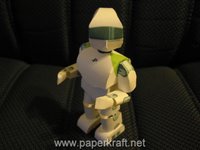

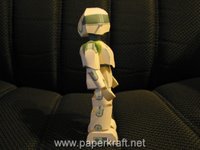
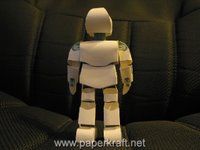

PINO Robot Papercraft






PINO Robot Papercraft
Homeschooling Carnival
This time it's up and running at Common Room. Enjoy!
Homeschooling Carnival
This time it's up and running at Common Room. Enjoy!
Monday, April 24, 2006
Reform math - we need a BALANCE
Recently Spunky wrote about reform math, and I feel I want to say something about it, too.
She was critizing the movement heavily. Some people call reform math 'new new math' or 'fuzzy math' (in a degrading way) - and like you can read in Spunky's post, sometimes when new ideas are implemented, it can cause math to become 'fuzzy' to the children.
But that is not necessarily a fault of the reform on a whole - maybe the teacher in question didn't understand how to implement the methods, or for some reason (unwisely) totally abandoned 'traditional' math fact drills.
I would say not all of the IDEAS that have come from this mathematics education reform are bad.
For example, encouraging kids to explore and investigate mathematical concepts, or discovering their own rules, can be a good thing. Group work CAN be a good thing.
The reformists promote understanding of concepts, problem solving, critical thinking. They try to distance themselves from the "drill ' n' kill" and rote memorization parts of traditional math education.
If kids "learn" math as a set of disconnected rules, they soon forget those since they never learned WHY they worked. (Well that can easily happen. I just witnessed it this past week; a youngster didn't know how to multiply two two-digit numbers since it had been so long that he had done it.)
The key is a BALANCE. Truth is somewhere in the middle. Kids absolutely need to learn their addition facts and memorize their multiplication facts. Otherwise, they're going to go about learning math without a FOUNDATION.
But, I feel it is very important to teach them also WHY the rules and procedures work.
For example, let kids learn how to multiply 2-digit numbers by 2-digit numbers. Let them practice. But also show them what it is based on (distributive property). They need to know that anyway in algebra class!
(For example: 34 x 58 is based on doing it in parts: 4 x 8, 4 x 50, 30 x 8, and 30 x 50, and adding all those. Compare to (x + 1) (2x - 5) which is done using distributive property.)
Learning to estimate and critically look at your final answer is very important, I feel. (For example, 34 x 58 is about 35 x 60, which is same as 70 x 30 = 2100. Exact answer is: 1972. OK.)
Let them SOMETIMES explore and investigate, find real-life connections. Occasional "math labs" can do much good in motivating and showing where math is useful in real life, letting them gain confidence, etc.
But if all the class time is spent on letting the kids find their own division methods and forgetting all about memorization, the pendulum has swung WAY too far to the other direction.
Memorization is needful, very needful. But let us not forget the 'reform' aspects of math altogether.
And like was pointed out in the comments to this post, it is the TEACHER that decides what is done in the math class and how it is done.
I feel the NAME of this reformist website summarizes it all: Mathematically Sane.
P.S. Here's a nice piece Newer Math by Jack Lee about what is going on at Seattle.
Tags: math, mathematics, reform, education
She was critizing the movement heavily. Some people call reform math 'new new math' or 'fuzzy math' (in a degrading way) - and like you can read in Spunky's post, sometimes when new ideas are implemented, it can cause math to become 'fuzzy' to the children.
But that is not necessarily a fault of the reform on a whole - maybe the teacher in question didn't understand how to implement the methods, or for some reason (unwisely) totally abandoned 'traditional' math fact drills.
I would say not all of the IDEAS that have come from this mathematics education reform are bad.
For example, encouraging kids to explore and investigate mathematical concepts, or discovering their own rules, can be a good thing. Group work CAN be a good thing.
The reformists promote understanding of concepts, problem solving, critical thinking. They try to distance themselves from the "drill ' n' kill" and rote memorization parts of traditional math education.
If kids "learn" math as a set of disconnected rules, they soon forget those since they never learned WHY they worked. (Well that can easily happen. I just witnessed it this past week; a youngster didn't know how to multiply two two-digit numbers since it had been so long that he had done it.)
The key is a BALANCE. Truth is somewhere in the middle. Kids absolutely need to learn their addition facts and memorize their multiplication facts. Otherwise, they're going to go about learning math without a FOUNDATION.
But, I feel it is very important to teach them also WHY the rules and procedures work.
For example, let kids learn how to multiply 2-digit numbers by 2-digit numbers. Let them practice. But also show them what it is based on (distributive property). They need to know that anyway in algebra class!
(For example: 34 x 58 is based on doing it in parts: 4 x 8, 4 x 50, 30 x 8, and 30 x 50, and adding all those. Compare to (x + 1) (2x - 5) which is done using distributive property.)
Learning to estimate and critically look at your final answer is very important, I feel. (For example, 34 x 58 is about 35 x 60, which is same as 70 x 30 = 2100. Exact answer is: 1972. OK.)
Let them SOMETIMES explore and investigate, find real-life connections. Occasional "math labs" can do much good in motivating and showing where math is useful in real life, letting them gain confidence, etc.
But if all the class time is spent on letting the kids find their own division methods and forgetting all about memorization, the pendulum has swung WAY too far to the other direction.
Memorization is needful, very needful. But let us not forget the 'reform' aspects of math altogether.
And like was pointed out in the comments to this post, it is the TEACHER that decides what is done in the math class and how it is done.
I feel the NAME of this reformist website summarizes it all: Mathematically Sane.
P.S. Here's a nice piece Newer Math by Jack Lee about what is going on at Seattle.
Tags: math, mathematics, reform, education
Reform math - we need a BALANCE
Recently Spunky wrote about reform math, and I feel I want to say something about it, too.
She was critizing the movement heavily. Some people call reform math 'new new math' or 'fuzzy math' (in a degrading way) - and like you can read in Spunky's post, sometimes when new ideas are implemented, it can cause math to become 'fuzzy' to the children.
But that is not necessarily a fault of the reform on a whole - maybe the teacher in question didn't understand how to implement the methods, or for some reason (unwisely) totally abandoned 'traditional' math fact drills.
I would say not all of the IDEAS that have come from this mathematics education reform are bad.
For example, encouraging kids to explore and investigate mathematical concepts, or discovering their own rules, can be a good thing. Group work CAN be a good thing.
The reformists promote understanding of concepts, problem solving, critical thinking. They try to distance themselves from the "drill ' n' kill" and rote memorization parts of traditional math education.
If kids "learn" math as a set of disconnected rules, they soon forget those since they never learned WHY they worked. (Well that can easily happen. I just witnessed it this past week; a youngster didn't know how to multiply two two-digit numbers since it had been so long that he had done it.)
The key is a BALANCE. Truth is somewhere in the middle. Kids absolutely need to learn their addition facts and memorize their multiplication facts. Otherwise, they're going to go about learning math without a FOUNDATION.
But, I feel it is very important to teach them also WHY the rules and procedures work.
For example, let kids learn how to multiply 2-digit numbers by 2-digit numbers. Let them practice. But also show them what it is based on (distributive property). They need to know that anyway in algebra class!
(For example: 34 x 58 is based on doing it in parts: 4 x 8, 4 x 50, 30 x 8, and 30 x 50, and adding all those. Compare to (x + 1) (2x - 5) which is done using distributive property.)
Learning to estimate and critically look at your final answer is very important, I feel. (For example, 34 x 58 is about 35 x 60, which is same as 70 x 30 = 2100. Exact answer is: 1972. OK.)
Let them SOMETIMES explore and investigate, find real-life connections. Occasional "math labs" can do much good in motivating and showing where math is useful in real life, letting them gain confidence, etc.
But if all the class time is spent on letting the kids find their own division methods and forgetting all about memorization, the pendulum has swung WAY too far to the other direction.
Memorization is needful, very needful. But let us not forget the 'reform' aspects of math altogether.
And like was pointed out in the comments to this post, it is the TEACHER that decides what is done in the math class and how it is done.
I feel the NAME of this reformist website summarizes it all: Mathematically Sane.
P.S. Here's a nice piece Newer Math by Jack Lee about what is going on at Seattle.
Tags: math, mathematics, reform, education
She was critizing the movement heavily. Some people call reform math 'new new math' or 'fuzzy math' (in a degrading way) - and like you can read in Spunky's post, sometimes when new ideas are implemented, it can cause math to become 'fuzzy' to the children.
But that is not necessarily a fault of the reform on a whole - maybe the teacher in question didn't understand how to implement the methods, or for some reason (unwisely) totally abandoned 'traditional' math fact drills.
I would say not all of the IDEAS that have come from this mathematics education reform are bad.
For example, encouraging kids to explore and investigate mathematical concepts, or discovering their own rules, can be a good thing. Group work CAN be a good thing.
The reformists promote understanding of concepts, problem solving, critical thinking. They try to distance themselves from the "drill ' n' kill" and rote memorization parts of traditional math education.
If kids "learn" math as a set of disconnected rules, they soon forget those since they never learned WHY they worked. (Well that can easily happen. I just witnessed it this past week; a youngster didn't know how to multiply two two-digit numbers since it had been so long that he had done it.)
The key is a BALANCE. Truth is somewhere in the middle. Kids absolutely need to learn their addition facts and memorize their multiplication facts. Otherwise, they're going to go about learning math without a FOUNDATION.
But, I feel it is very important to teach them also WHY the rules and procedures work.
For example, let kids learn how to multiply 2-digit numbers by 2-digit numbers. Let them practice. But also show them what it is based on (distributive property). They need to know that anyway in algebra class!
(For example: 34 x 58 is based on doing it in parts: 4 x 8, 4 x 50, 30 x 8, and 30 x 50, and adding all those. Compare to (x + 1) (2x - 5) which is done using distributive property.)
Learning to estimate and critically look at your final answer is very important, I feel. (For example, 34 x 58 is about 35 x 60, which is same as 70 x 30 = 2100. Exact answer is: 1972. OK.)
Let them SOMETIMES explore and investigate, find real-life connections. Occasional "math labs" can do much good in motivating and showing where math is useful in real life, letting them gain confidence, etc.
But if all the class time is spent on letting the kids find their own division methods and forgetting all about memorization, the pendulum has swung WAY too far to the other direction.
Memorization is needful, very needful. But let us not forget the 'reform' aspects of math altogether.
And like was pointed out in the comments to this post, it is the TEACHER that decides what is done in the math class and how it is done.
I feel the NAME of this reformist website summarizes it all: Mathematically Sane.
P.S. Here's a nice piece Newer Math by Jack Lee about what is going on at Seattle.
Tags: math, mathematics, reform, education
Saturday, April 22, 2006
ifbot Papercraft
From Robosquare.org, here's a paper model of a robot called "ifbot". ifbot is an advance communication robot that can understand and speak human language (only Japanese language for now), it can also move by itself, avoid obstacles, detect steps, take pictures and send them wirelessly via the internet, and last but not the least, it can recognize upto ten persons from their voices and faces and adapt to the emotional tones of the speaker. It is marketed in Japan as a domestic communication robot primarily for elderly people to provide conversation and companionship. This paper model is in PDF format, the pattern comes in two pages and one page for instructions.
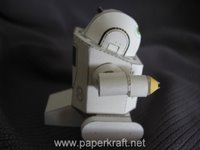
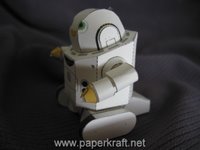
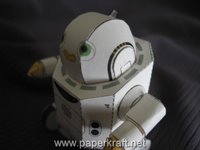

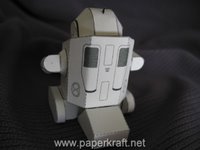
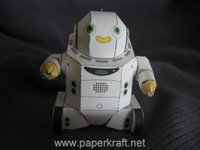
ifbot Papercraft






ifbot Papercraft
Friday, April 21, 2006
Living math
I've been looking over the website LivingMath.net recently. Lots of good stuff there.
What is 'living math'? How do you make math "come to life"?
Well, I guess we could ask that when did math become 'dead' and who killed it?
Some people feel that it is worksheets, tests, drill, and 'scope and sequence' that killed it. But I don't feel it's that simple. Those things are tools you can use, and they don't necessarily make math 'all dead'.
There are many ways to make math 'living'. One important way, I feel, is to show your kids when you do use math in your daily life. I've written about it before.
When YOU use math, it conveys the idea that math and numbers are things we use, not some obscure school subject that one does for half an hour five times a week, and then tries to forget the rest of the time.
I have never understood mothers who say they didn't like math, hated it, etc. Don't say that! That attitude will be absorbed by the little 'sponges' around you...
When kids are little, play counting games with them - show them math is part of life, part of the fun. Point out 'math' situations in life, such as: here are two plates, and then two more. Or, here's six toy cars but see, two of them drive away. Oh, look: three bikes, each of them has two wheels. Have measuring tapes, rulers, scales, calendars around your house.
When they're older and you go shopping, try 'think aloud' how you figure out comparing prices, or how you mentally calculate discounts, or do your taxes etc.
You don't have to be an 'unschooler' to use some of these ideas. Just go visit the LivingMath.net site for some more: Julie has made a page with lots of simple ideas how to make math LIVING!
Tags: math, lessons
What is 'living math'? How do you make math "come to life"?
Well, I guess we could ask that when did math become 'dead' and who killed it?
Some people feel that it is worksheets, tests, drill, and 'scope and sequence' that killed it. But I don't feel it's that simple. Those things are tools you can use, and they don't necessarily make math 'all dead'.
There are many ways to make math 'living'. One important way, I feel, is to show your kids when you do use math in your daily life. I've written about it before.
When YOU use math, it conveys the idea that math and numbers are things we use, not some obscure school subject that one does for half an hour five times a week, and then tries to forget the rest of the time.
I have never understood mothers who say they didn't like math, hated it, etc. Don't say that! That attitude will be absorbed by the little 'sponges' around you...
When kids are little, play counting games with them - show them math is part of life, part of the fun. Point out 'math' situations in life, such as: here are two plates, and then two more. Or, here's six toy cars but see, two of them drive away. Oh, look: three bikes, each of them has two wheels. Have measuring tapes, rulers, scales, calendars around your house.
When they're older and you go shopping, try 'think aloud' how you figure out comparing prices, or how you mentally calculate discounts, or do your taxes etc.
You don't have to be an 'unschooler' to use some of these ideas. Just go visit the LivingMath.net site for some more: Julie has made a page with lots of simple ideas how to make math LIVING!
Tags: math, lessons
Living math
I've been looking over the website LivingMath.net recently. Lots of good stuff there.
What is 'living math'? How do you make math "come to life"?
Well, I guess we could ask that when did math become 'dead' and who killed it?
Some people feel that it is worksheets, tests, drill, and 'scope and sequence' that killed it. But I don't feel it's that simple. Those things are tools you can use, and they don't necessarily make math 'all dead'.
There are many ways to make math 'living'. One important way, I feel, is to show your kids when you do use math in your daily life. I've written about it before.
When YOU use math, it conveys the idea that math and numbers are things we use, not some obscure school subject that one does for half an hour five times a week, and then tries to forget the rest of the time.
I have never understood mothers who say they didn't like math, hated it, etc. Don't say that! That attitude will be absorbed by the little 'sponges' around you...
When kids are little, play counting games with them - show them math is part of life, part of the fun. Point out 'math' situations in life, such as: here are two plates, and then two more. Or, here's six toy cars but see, two of them drive away. Oh, look: three bikes, each of them has two wheels. Have measuring tapes, rulers, scales, calendars around your house.
When they're older and you go shopping, try 'think aloud' how you figure out comparing prices, or how you mentally calculate discounts, or do your taxes etc.
You don't have to be an 'unschooler' to use some of these ideas. Just go visit the LivingMath.net site for some more: Julie has made a page with lots of simple ideas how to make math LIVING!
Tags: math, lessons
What is 'living math'? How do you make math "come to life"?
Well, I guess we could ask that when did math become 'dead' and who killed it?
Some people feel that it is worksheets, tests, drill, and 'scope and sequence' that killed it. But I don't feel it's that simple. Those things are tools you can use, and they don't necessarily make math 'all dead'.
There are many ways to make math 'living'. One important way, I feel, is to show your kids when you do use math in your daily life. I've written about it before.
When YOU use math, it conveys the idea that math and numbers are things we use, not some obscure school subject that one does for half an hour five times a week, and then tries to forget the rest of the time.
I have never understood mothers who say they didn't like math, hated it, etc. Don't say that! That attitude will be absorbed by the little 'sponges' around you...
When kids are little, play counting games with them - show them math is part of life, part of the fun. Point out 'math' situations in life, such as: here are two plates, and then two more. Or, here's six toy cars but see, two of them drive away. Oh, look: three bikes, each of them has two wheels. Have measuring tapes, rulers, scales, calendars around your house.
When they're older and you go shopping, try 'think aloud' how you figure out comparing prices, or how you mentally calculate discounts, or do your taxes etc.
You don't have to be an 'unschooler' to use some of these ideas. Just go visit the LivingMath.net site for some more: Julie has made a page with lots of simple ideas how to make math LIVING!
Tags: math, lessons
Thursday, April 20, 2006
The Math Goodies CD review
I've recently reviewed The Math Goodies CD - it is full of math lessons, interactive exercises, worksheets, crossword puzzles and an interactive Integer Football game. It's mostly for grades 5-8; however the lessons on symbolic logic better suit grades 7-10.
To summarize the lessons in one word, I'd use the word CLARITY. They are very clearly presented. The interactive exercises make it good for a student learning on his/her own.
Read more here!
Tags: math, lessons
To summarize the lessons in one word, I'd use the word CLARITY. They are very clearly presented. The interactive exercises make it good for a student learning on his/her own.
Read more here!
Tags: math, lessons
The Math Goodies CD review
I've recently reviewed The Math Goodies CD - it is full of math lessons, interactive exercises, worksheets, crossword puzzles and an interactive Integer Football game. It's mostly for grades 5-8; however the lessons on symbolic logic better suit grades 7-10.
To summarize the lessons in one word, I'd use the word CLARITY. They are very clearly presented. The interactive exercises make it good for a student learning on his/her own.
Read more here!
Tags: math, lessons
To summarize the lessons in one word, I'd use the word CLARITY. They are very clearly presented. The interactive exercises make it good for a student learning on his/her own.
Read more here!
Tags: math, lessons
Wednesday, April 19, 2006
Dog Papercraft - Corgi
It's official, summer has landed in my town. Even though its still spring time, down here in Texas we are already close to hundred degree temperature and rolling-blackouts are abound. In recognition of the term "dog days", here's a paper model of a dog (corgi) from Kei Craft studio. Hosted and created by Kei Craft, the file comes in PDF format and includes a pattern (386KB) and instructions (288KB). Have Fun!


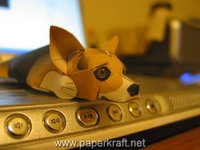


Corgi Papercraft [Keicraft]
Instructions





Corgi Papercraft [Keicraft]
Instructions
Tuesday, April 18, 2006
Comparing two third grade math books
As I mentioned, I have recently started on a new project in creating a worksheet package for third grade. So... I have had to take a real close look on what exact topics are usually taught in third-grade math.
I have been looking at two third-grade (public school) math books. One is from 1978, the other from 1992.
I have been quite amazed at the differences between the two! I knew about the 'trend' in mathematics curriculum where topics seem to get introduced on earlier and earlier grades. But it was eye-opening to see it "in action" in comparing the books.
I think it's good for homeschoolers to be aware of this trend, too.
The 1978 book is full-color, illustrated, very clear layout, and fairly little text. The word problems are extremely word-scarce. They've even put little symbols in the text instead of words (for sandcastle or beaver or squirrel or an LP record player, for example).
The 1992 book is still full color of course, less clear layout, and this time lots of text. Each lesson starts with a "story" or example situation from real life that takes lots of text and almost the whole page.
The problems in the 1978 book are simpler, often just a bunch of calculation problems.
In the 1992 book the problems are much more varied, and there are always word problems included in every lesson - often also "critical thinking" problems. And, in every chapter between your 'standard' lessons there are 2 Problem solving lessons, a Decision Making lesson, Thinking Mathematically lesson, and Curriculum Connection and Technology pages.
Besides those, one great difference is in the amount of topics covered: the 1978 book does not have a hint of decimals, adding fractions, mixed numbers, statistics, probability, or long division. It also does not include measuring mass/weight. Division is only by 1-9. In the latter book all those are included, plus the division topics get to be more advanced.
The 1978 book is long - 321 lesson pages - but the 1992 book is just enormous in size: 516 pages.
And in 2006, mathematics texts haven't gotten any shorter: It is now routine for elementary texts to be over 600 pages long!!!
I can't but pity the teachers: how in the world can they go through all that? My guess is, they can't and don't. If you have better information on what teachers actually do, you're welcome to comment.
I'm not saying the things in the 1992 book aren't important. Word problems are important. Thinking mathematically is of course important.
But does it really help to study mixed numbers, probability, coordinate system, even long division on 3rd grade? Those topics are 'introduced' for a lesson or two only anyway - kind of 'exploratory' lessons. Are kids going to remember them?
In my mind, third grade is the grade to learn your multiplication facts and concept of division, and get better at addition/subtraction and bigger numbers and simple word problems.
My fear is that making the curriculum "mile wide" this way takes away from the 'core' topics, and thereby can actually hinder one's learning of fraction arithmetic later on, for example.
J. D. Fisher offers in his blog one viewpoint to the "long-book" phenomenon: that it is caused by linearization of texts. Students can't read reflectively so need everything spelled out, which takes lots of pages. That, and he also says that publishers cannot omit any content to make books shorter.
Tags: math, curriculum, elementary
I have been looking at two third-grade (public school) math books. One is from 1978, the other from 1992.
I have been quite amazed at the differences between the two! I knew about the 'trend' in mathematics curriculum where topics seem to get introduced on earlier and earlier grades. But it was eye-opening to see it "in action" in comparing the books.
I think it's good for homeschoolers to be aware of this trend, too.
The 1978 book is full-color, illustrated, very clear layout, and fairly little text. The word problems are extremely word-scarce. They've even put little symbols in the text instead of words (for sandcastle or beaver or squirrel or an LP record player, for example).
The 1992 book is still full color of course, less clear layout, and this time lots of text. Each lesson starts with a "story" or example situation from real life that takes lots of text and almost the whole page.
The problems in the 1978 book are simpler, often just a bunch of calculation problems.
In the 1992 book the problems are much more varied, and there are always word problems included in every lesson - often also "critical thinking" problems. And, in every chapter between your 'standard' lessons there are 2 Problem solving lessons, a Decision Making lesson, Thinking Mathematically lesson, and Curriculum Connection and Technology pages.
Besides those, one great difference is in the amount of topics covered: the 1978 book does not have a hint of decimals, adding fractions, mixed numbers, statistics, probability, or long division. It also does not include measuring mass/weight. Division is only by 1-9. In the latter book all those are included, plus the division topics get to be more advanced.
The 1978 book is long - 321 lesson pages - but the 1992 book is just enormous in size: 516 pages.
And in 2006, mathematics texts haven't gotten any shorter: It is now routine for elementary texts to be over 600 pages long!!!
I can't but pity the teachers: how in the world can they go through all that? My guess is, they can't and don't. If you have better information on what teachers actually do, you're welcome to comment.
I'm not saying the things in the 1992 book aren't important. Word problems are important. Thinking mathematically is of course important.
But does it really help to study mixed numbers, probability, coordinate system, even long division on 3rd grade? Those topics are 'introduced' for a lesson or two only anyway - kind of 'exploratory' lessons. Are kids going to remember them?
In my mind, third grade is the grade to learn your multiplication facts and concept of division, and get better at addition/subtraction and bigger numbers and simple word problems.
My fear is that making the curriculum "mile wide" this way takes away from the 'core' topics, and thereby can actually hinder one's learning of fraction arithmetic later on, for example.
J. D. Fisher offers in his blog one viewpoint to the "long-book" phenomenon: that it is caused by linearization of texts. Students can't read reflectively so need everything spelled out, which takes lots of pages. That, and he also says that publishers cannot omit any content to make books shorter.
Tags: math, curriculum, elementary
Comparing two third grade math books
As I mentioned, I have recently started on a new project in creating a worksheet package for third grade. So... I have had to take a real close look on what exact topics are usually taught in third-grade math.
I have been looking at two third-grade (public school) math books. One is from 1978, the other from 1992.
I have been quite amazed at the differences between the two! I knew about the 'trend' in mathematics curriculum where topics seem to get introduced on earlier and earlier grades. But it was eye-opening to see it "in action" in comparing the books.
I think it's good for homeschoolers to be aware of this trend, too.
The 1978 book is full-color, illustrated, very clear layout, and fairly little text. The word problems are extremely word-scarce. They've even put little symbols in the text instead of words (for sandcastle or beaver or squirrel or an LP record player, for example).
The 1992 book is still full color of course, less clear layout, and this time lots of text. Each lesson starts with a "story" or example situation from real life that takes lots of text and almost the whole page.
The problems in the 1978 book are simpler, often just a bunch of calculation problems.
In the 1992 book the problems are much more varied, and there are always word problems included in every lesson - often also "critical thinking" problems. And, in every chapter between your 'standard' lessons there are 2 Problem solving lessons, a Decision Making lesson, Thinking Mathematically lesson, and Curriculum Connection and Technology pages.
Besides those, one great difference is in the amount of topics covered: the 1978 book does not have a hint of decimals, adding fractions, mixed numbers, statistics, probability, or long division. It also does not include measuring mass/weight. Division is only by 1-9. In the latter book all those are included, plus the division topics get to be more advanced.
The 1978 book is long - 321 lesson pages - but the 1992 book is just enormous in size: 516 pages.
And in 2006, mathematics texts haven't gotten any shorter: It is now routine for elementary texts to be over 600 pages long!!!
I can't but pity the teachers: how in the world can they go through all that? My guess is, they can't and don't. If you have better information on what teachers actually do, you're welcome to comment.
I'm not saying the things in the 1992 book aren't important. Word problems are important. Thinking mathematically is of course important.
But does it really help to study mixed numbers, probability, coordinate system, even long division on 3rd grade? Those topics are 'introduced' for a lesson or two only anyway - kind of 'exploratory' lessons. Are kids going to remember them?
In my mind, third grade is the grade to learn your multiplication facts and concept of division, and get better at addition/subtraction and bigger numbers and simple word problems.
My fear is that making the curriculum "mile wide" this way takes away from the 'core' topics, and thereby can actually hinder one's learning of fraction arithmetic later on, for example.
J. D. Fisher offers in his blog one viewpoint to the "long-book" phenomenon: that it is caused by linearization of texts. Students can't read reflectively so need everything spelled out, which takes lots of pages. That, and he also says that publishers cannot omit any content to make books shorter.
Tags: math, curriculum, elementary
I have been looking at two third-grade (public school) math books. One is from 1978, the other from 1992.
I have been quite amazed at the differences between the two! I knew about the 'trend' in mathematics curriculum where topics seem to get introduced on earlier and earlier grades. But it was eye-opening to see it "in action" in comparing the books.
I think it's good for homeschoolers to be aware of this trend, too.
The 1978 book is full-color, illustrated, very clear layout, and fairly little text. The word problems are extremely word-scarce. They've even put little symbols in the text instead of words (for sandcastle or beaver or squirrel or an LP record player, for example).
The 1992 book is still full color of course, less clear layout, and this time lots of text. Each lesson starts with a "story" or example situation from real life that takes lots of text and almost the whole page.
The problems in the 1978 book are simpler, often just a bunch of calculation problems.
In the 1992 book the problems are much more varied, and there are always word problems included in every lesson - often also "critical thinking" problems. And, in every chapter between your 'standard' lessons there are 2 Problem solving lessons, a Decision Making lesson, Thinking Mathematically lesson, and Curriculum Connection and Technology pages.
Besides those, one great difference is in the amount of topics covered: the 1978 book does not have a hint of decimals, adding fractions, mixed numbers, statistics, probability, or long division. It also does not include measuring mass/weight. Division is only by 1-9. In the latter book all those are included, plus the division topics get to be more advanced.
The 1978 book is long - 321 lesson pages - but the 1992 book is just enormous in size: 516 pages.
And in 2006, mathematics texts haven't gotten any shorter: It is now routine for elementary texts to be over 600 pages long!!!
I can't but pity the teachers: how in the world can they go through all that? My guess is, they can't and don't. If you have better information on what teachers actually do, you're welcome to comment.
I'm not saying the things in the 1992 book aren't important. Word problems are important. Thinking mathematically is of course important.
But does it really help to study mixed numbers, probability, coordinate system, even long division on 3rd grade? Those topics are 'introduced' for a lesson or two only anyway - kind of 'exploratory' lessons. Are kids going to remember them?
In my mind, third grade is the grade to learn your multiplication facts and concept of division, and get better at addition/subtraction and bigger numbers and simple word problems.
My fear is that making the curriculum "mile wide" this way takes away from the 'core' topics, and thereby can actually hinder one's learning of fraction arithmetic later on, for example.
J. D. Fisher offers in his blog one viewpoint to the "long-book" phenomenon: that it is caused by linearization of texts. Students can't read reflectively so need everything spelled out, which takes lots of pages. That, and he also says that publishers cannot omit any content to make books shorter.
Tags: math, curriculum, elementary
Friday, April 14, 2006
Clock worksheets
I've embarked on a new project in making worksheet collections for each grade from 3rd through 8th.
While doing that, I had to generate images of clock faces, and so I decided to just use a few hours to make a worksheet generator at the same time.
So if you're interested, click here to make clock worksheets. It's pretty simple, just two things you can do: either the student has to read the analog clock, or draw hands on it when time is given in digital form.
While doing that, I had to generate images of clock faces, and so I decided to just use a few hours to make a worksheet generator at the same time.
So if you're interested, click here to make clock worksheets. It's pretty simple, just two things you can do: either the student has to read the analog clock, or draw hands on it when time is given in digital form.
Clock worksheets
I've embarked on a new project in making worksheet collections for each grade from 3rd through 8th.
While doing that, I had to generate images of clock faces, and so I decided to just use a few hours to make a worksheet generator at the same time.
So if you're interested, click here to make clock worksheets. It's pretty simple, just two things you can do: either the student has to read the analog clock, or draw hands on it when time is given in digital form.
While doing that, I had to generate images of clock faces, and so I decided to just use a few hours to make a worksheet generator at the same time.
So if you're interested, click here to make clock worksheets. It's pretty simple, just two things you can do: either the student has to read the analog clock, or draw hands on it when time is given in digital form.
KONISHIKI
Konishiki Yasokichi is a Hawaii-born Samoan sumo wrestler who became famous in Japan for being the first foreign born champion (Ozeki) in the sport of sumo. Ozeki, being the second highest rank in sumo follows after Yokozuna. He stirred up a debate in Japan on whether a foreigner could have the necessary cultural understanding to be acceptable in sumo's ultimate rank. Konishiki was also the heaviest ever in sumo at a typical fighting weight of 270kg (595 pounds). This paper model of KONISHIKI is provided through his web site, Konishiki.net. The paper model is in PDF format and comes with a pattern(1.2MB) and instructions(444KB).
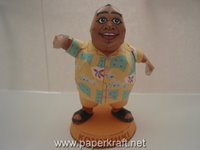
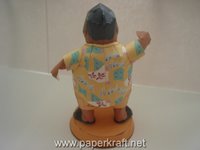
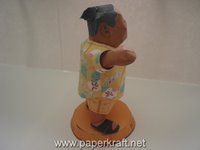
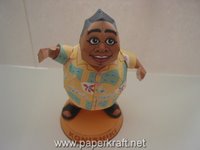
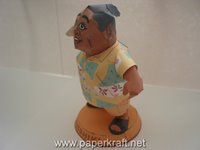
KONISHIKI - http://www.konishiki.net/jp/download/i/pc_setsumeizu.pdf
Instructions - http://www.konishiki.net/jp/download/i/pc_tenkaizu.pdf





KONISHIKI - http://www.konishiki.net/jp/download/i/pc_setsumeizu.pdf
Instructions - http://www.konishiki.net/jp/download/i/pc_tenkaizu.pdf
Thursday, April 13, 2006
Multiplication Division 2 ebook updated
My ebook Multiplication Division 2 has been updated on the part of long division; it is more of an approach of smaller steps now: first divide numbers where there are no remainders at all (for example 684/2), then if there's a remainder in the ones (685/2), or in the tens (658/2). Then learn to look at two digits of the dividend if not enough hundreds (345/5), or place a zero in quotient (832/4) etc. Lastly the case with most steps.
Price: $3.
Tags: math, lessons
Price: $3.
Tags: math, lessons
Multiplication Division 2 ebook updated
My ebook Multiplication Division 2 has been updated on the part of long division; it is more of an approach of smaller steps now: first divide numbers where there are no remainders at all (for example 684/2), then if there's a remainder in the ones (685/2), or in the tens (658/2). Then learn to look at two digits of the dividend if not enough hundreds (345/5), or place a zero in quotient (832/4) etc. Lastly the case with most steps.
Price: $3.
Tags: math, lessons
Price: $3.
Tags: math, lessons
Wednesday, April 12, 2006
Finding values of sine without a calculator
How do I find the sin or inverse sin of 46 degrees (or any degree) without using a calculator?
Thanks.
Jackie
Finding an "inverse sin" doesn't apply to degrees by the way. We take sine of an angle and get a number; inverse sine is taken from a number and gives back an angle.
So is it possible to find values of sine without a calculator? I am sure there are various methods, but these two came to my mind.
Tags: sine, calculator
Thanks.
Jackie
Finding an "inverse sin" doesn't apply to degrees by the way. We take sine of an angle and get a number; inverse sine is taken from a number and gives back an angle.
So is it possible to find values of sine without a calculator? I am sure there are various methods, but these two came to my mind.
1) We can go back to the definition of sine in a right triangle and using a protractor, DRAW a right triangle with that angle. Draw as accurately as you can.
Then from the picture again, we need to measure the two sides: the opposite side and the hypotenuse and then calculate their ratio (paper and pencil). Again, measure as accurately as you can.
Now, as far as the opposite problem, let's say you know that the sine of some angle is 0.86 or some other number (between -1 and 1). Can we find the angle without the calculator?
Draw a right triangle with hypotenuse 1, opposite side 0.86 (or some multiple of those), and measure the angle in degrees.
This method, I feel, is a good one for demonstration and teaching purposes when first learning about sine.
2) Another possibility is to use the Taylor series of sine. Hopefully you don't need to take too many terms from it to get the desirable accuracy. This will include calculations that you'd need to do on paper.
Let's say we use Taylor series in origin and take the first four terms:
sin(x) ≈ x - x3/3! + x5/5! - x7/7!
To use this, you need to first change the 46 degrees or whatever to radians. Obviously all the calculations involved will take some time without a calculator... Auch! But an approximative method such as this that only involves the four basic operations is what your calculator probably uses, too.
Here you will find the Taylor series for inverse of sine.
3) Using sine addition formula and a known value.
Sine addition formula says:
sin(a + b) = sin a cos b + cos a sin b.
So... if you're interested in finding, say, sin(46°) and we do already happen to know sin(45°) and cos(45°)... but we need to work in radians to use the formula. So convert 46 and 45 degrees to radians (without a calculator? I'm going to cheat now...) and get 45° is Pi/4 or 0.785398, 46° is about 0.80285.
sin(Pi/4 + 0.01745) = sin(Pi/4) cos(0.01745) + cos(Pi/4) sin(0.01745).
It just so happens that for small values of x (near zero), sin x ≈ x. (You learn that in calculus, I think). So sin(0.01745) is about 0.01745. Cos(0.01745) should be pretty near 1 somewhere.
sin(Pi/4) or sin 45° is 1/√2, and cos(Pi/4) is the same. Plugging those in,
sin(Pi/4 + 0.01745) = 1/√2 * 1 + 1/√2 *0.01745.
I'm going to cheat again and do this with a calculator... to get 0.71945.
Did I get close? Well, sin46° is about 0.7193398. Got three decimals right; that's okay I guess.
Tags: sine, calculator
Finding values of sine without a calculator
How do I find the sin or inverse sin of 46 degrees (or any degree) without using a calculator?
Thanks.
Jackie
Finding an "inverse sin" doesn't apply to degrees by the way. We take sine of an angle and get a number; inverse sine is taken from a number and gives back an angle.
So is it possible to find values of sine without a calculator? I am sure there are various methods, but these two came to my mind.
Tags: sine, calculator
Thanks.
Jackie
Finding an "inverse sin" doesn't apply to degrees by the way. We take sine of an angle and get a number; inverse sine is taken from a number and gives back an angle.
So is it possible to find values of sine without a calculator? I am sure there are various methods, but these two came to my mind.
1) We can go back to the definition of sine in a right triangle and using a protractor, DRAW a right triangle with that angle. Draw as accurately as you can.
Then from the picture again, we need to measure the two sides: the opposite side and the hypotenuse and then calculate their ratio (paper and pencil). Again, measure as accurately as you can.
Now, as far as the opposite problem, let's say you know that the sine of some angle is 0.86 or some other number (between -1 and 1). Can we find the angle without the calculator?
Draw a right triangle with hypotenuse 1, opposite side 0.86 (or some multiple of those), and measure the angle in degrees.
This method, I feel, is a good one for demonstration and teaching purposes when first learning about sine.
2) Another possibility is to use the Taylor series of sine. Hopefully you don't need to take too many terms from it to get the desirable accuracy. This will include calculations that you'd need to do on paper.
Let's say we use Taylor series in origin and take the first four terms:
sin(x) ≈ x - x3/3! + x5/5! - x7/7!
To use this, you need to first change the 46 degrees or whatever to radians. Obviously all the calculations involved will take some time without a calculator... Auch! But an approximative method such as this that only involves the four basic operations is what your calculator probably uses, too.
Here you will find the Taylor series for inverse of sine.
3) Using sine addition formula and a known value.
Sine addition formula says:
sin(a + b) = sin a cos b + cos a sin b.
So... if you're interested in finding, say, sin(46°) and we do already happen to know sin(45°) and cos(45°)... but we need to work in radians to use the formula. So convert 46 and 45 degrees to radians (without a calculator? I'm going to cheat now...) and get 45° is Pi/4 or 0.785398, 46° is about 0.80285.
sin(Pi/4 + 0.01745) = sin(Pi/4) cos(0.01745) + cos(Pi/4) sin(0.01745).
It just so happens that for small values of x (near zero), sin x ≈ x. (You learn that in calculus, I think). So sin(0.01745) is about 0.01745. Cos(0.01745) should be pretty near 1 somewhere.
sin(Pi/4) or sin 45° is 1/√2, and cos(Pi/4) is the same. Plugging those in,
sin(Pi/4 + 0.01745) = 1/√2 * 1 + 1/√2 *0.01745.
I'm going to cheat again and do this with a calculator... to get 0.71945.
Did I get close? Well, sin46° is about 0.7193398. Got three decimals right; that's okay I guess.
Tags: sine, calculator
Sunday, April 9, 2006
Mathematics and internet security

April is math awareness month - this year with the theme of internet security. Are you aware that mathematics is used extensively in that?
By now, we are used to shopping online and to "secure sites" where our credit card information is sent via encryption to the merchant.
But do you know what kind of mathematics is behind that? It is based on number theory - the branch of mathematics that looks at whole numbers and the special properties some of them have, such as being a prime.
In 1970s, a group of researchers developed a way to encrypt and decrypt data WITHOUT the need of the parties first sharing the encryption key.
You see, in traditional cryptography, the two parties wishing to exchange secret information first have to somehow let each other know the encryption/decryption 'key'. And that cannot be encrypted.
What if you can't do that? What if the parties haven't had previous contact with each other to share the key?
This exact problem led to the invention of RSA public-key cryptosystem
in 1977 by Ronald Rivest, Adi Shamir and Leonard Adleman.
It was different from the past cryptosystems because in it, the encryption key is different from decryption key, and the former could be made public.
Since the encryption key is public, anyone can encrypt messages (and send them to the online merchant). But only the party with the decryption key can decrypt them.
This is all based on the fact that some mathematical problems (or operations) are easy to do, while some others are very difficult. For example, it is easy to find large primes, and it is easy to multiply them. But it is very difficult to factor a large integer. So even if the large integer is made public, it's not too likely that someone will recover the two primes that were multiplied.
You can read more in this introductory level article The Mathematics of the RSA Public-Key Cryptosystem by Burt Kaliski who works at RSA Laboratories.
The mathematics behind RSA system is kind of fascinating, but requires understanding what modular arithmetic is. (Which is basically "remainder arithmetic" - 23 mod 4 means 'remainder when 23 is divided by 4'.) If you don't want to delve into all that, you can just skim through the mathematics parts and enjoy the rest of the article anyway.
Another article of interest is "Cracking the Code" by Keith Devlin. In it, he discusses messages (such as password) that are sent scrambled via the use of a "hash" function, and how Xiaoyun Wang (one of the good guys) seems to have special intuition to be able to break the code!
Also visit the main site of Mathematics Awareness Month for more articles and info.
Tags: math, mathematics
Mathematics and internet security

April is math awareness month - this year with the theme of internet security. Are you aware that mathematics is used extensively in that?
By now, we are used to shopping online and to "secure sites" where our credit card information is sent via encryption to the merchant.
But do you know what kind of mathematics is behind that? It is based on number theory - the branch of mathematics that looks at whole numbers and the special properties some of them have, such as being a prime.
In 1970s, a group of researchers developed a way to encrypt and decrypt data WITHOUT the need of the parties first sharing the encryption key.
You see, in traditional cryptography, the two parties wishing to exchange secret information first have to somehow let each other know the encryption/decryption 'key'. And that cannot be encrypted.
What if you can't do that? What if the parties haven't had previous contact with each other to share the key?
This exact problem led to the invention of RSA public-key cryptosystem
in 1977 by Ronald Rivest, Adi Shamir and Leonard Adleman.
It was different from the past cryptosystems because in it, the encryption key is different from decryption key, and the former could be made public.
Since the encryption key is public, anyone can encrypt messages (and send them to the online merchant). But only the party with the decryption key can decrypt them.
This is all based on the fact that some mathematical problems (or operations) are easy to do, while some others are very difficult. For example, it is easy to find large primes, and it is easy to multiply them. But it is very difficult to factor a large integer. So even if the large integer is made public, it's not too likely that someone will recover the two primes that were multiplied.
You can read more in this introductory level article The Mathematics of the RSA Public-Key Cryptosystem by Burt Kaliski who works at RSA Laboratories.
The mathematics behind RSA system is kind of fascinating, but requires understanding what modular arithmetic is. (Which is basically "remainder arithmetic" - 23 mod 4 means 'remainder when 23 is divided by 4'.) If you don't want to delve into all that, you can just skim through the mathematics parts and enjoy the rest of the article anyway.
Another article of interest is "Cracking the Code" by Keith Devlin. In it, he discusses messages (such as password) that are sent scrambled via the use of a "hash" function, and how Xiaoyun Wang (one of the good guys) seems to have special intuition to be able to break the code!
Also visit the main site of Mathematics Awareness Month for more articles and info.
Tags: math, mathematics
Friday, April 7, 2006
Homeschool Blog Watch started
Gary at HomeschoolBuzz.com has started a Homeschool Blog Watch - it tracks headlines from selected homeschooling blogs and is updated as new posts appear. In other words, you can kind of check out several blogs all at once.
Homeschool Blog Watch started
Gary at HomeschoolBuzz.com has started a Homeschool Blog Watch - it tracks headlines from selected homeschooling blogs and is updated as new posts appear. In other words, you can kind of check out several blogs all at once.
Distance = velocity * time, or Calculus Without Tears
You can learn calculus concepts starting from the formula distance = velocity * time.
Yes, that's true. That's what the book Calculus Without Tears is all about. It starts from the simple situation of a runner running with constant speed (velocity), and goes very step-by-step into actual calculus concepts, such as derivative, area under curve (integration), and differential equations.
The idea of the book is to make basic calculus concepts accessible to younger students, without need of much algebra.
Like I said earlier, calculus is the mathematics of change. It is usually studied as the last course in high school, or early in college studies. So should one study it earlier? I am sure people have varying opinions on that.
Certainly the aim of this book is NOT to further crowd the "mile wide" mathematics curriculum. But it provides something extra for gifted kids, or for students very interested in calculus and math (and physics). It also provides an alternative way to study calculus and can help students understand it better.
I enjoyed reading thru volumes 1 and 2. It is kind of a different approach, but can really make the student think and understand the concepts better. Too often, learning calculus becomes "mindless symbol manipulation" without much insight into what's happening.
Volume 1 of Calculus Without Tears concentrates on motion with constant velocity, modeling that with a function, graphing the situation, derivative in it (the velocity), area under a curve, and differential equations involved.
Volume 2 deals with the 'falling apple' - motion with constant acceleration, which is described by a quadratic function.
Volume 3 is about nature's favorite functions, such as polynomials, the exponential and trigonometric functions, roots and radicals.
So if you're curious, you can read my review, or go see the author William Flannery's site.
Tags: math, calculus, gifted
Yes, that's true. That's what the book Calculus Without Tears is all about. It starts from the simple situation of a runner running with constant speed (velocity), and goes very step-by-step into actual calculus concepts, such as derivative, area under curve (integration), and differential equations.
The idea of the book is to make basic calculus concepts accessible to younger students, without need of much algebra.
Like I said earlier, calculus is the mathematics of change. It is usually studied as the last course in high school, or early in college studies. So should one study it earlier? I am sure people have varying opinions on that.
Certainly the aim of this book is NOT to further crowd the "mile wide" mathematics curriculum. But it provides something extra for gifted kids, or for students very interested in calculus and math (and physics). It also provides an alternative way to study calculus and can help students understand it better.
I enjoyed reading thru volumes 1 and 2. It is kind of a different approach, but can really make the student think and understand the concepts better. Too often, learning calculus becomes "mindless symbol manipulation" without much insight into what's happening.
Volume 1 of Calculus Without Tears concentrates on motion with constant velocity, modeling that with a function, graphing the situation, derivative in it (the velocity), area under a curve, and differential equations involved.
Volume 2 deals with the 'falling apple' - motion with constant acceleration, which is described by a quadratic function.
Volume 3 is about nature's favorite functions, such as polynomials, the exponential and trigonometric functions, roots and radicals.
So if you're curious, you can read my review, or go see the author William Flannery's site.
Tags: math, calculus, gifted
Distance = velocity * time, or Calculus Without Tears
You can learn calculus concepts starting from the formula distance = velocity * time.
Yes, that's true. That's what the book Calculus Without Tears is all about. It starts from the simple situation of a runner running with constant speed (velocity), and goes very step-by-step into actual calculus concepts, such as derivative, area under curve (integration), and differential equations.
The idea of the book is to make basic calculus concepts accessible to younger students, without need of much algebra.
Like I said earlier, calculus is the mathematics of change. It is usually studied as the last course in high school, or early in college studies. So should one study it earlier? I am sure people have varying opinions on that.
Certainly the aim of this book is NOT to further crowd the "mile wide" mathematics curriculum. But it provides something extra for gifted kids, or for students very interested in calculus and math (and physics). It also provides an alternative way to study calculus and can help students understand it better.
I enjoyed reading thru volumes 1 and 2. It is kind of a different approach, but can really make the student think and understand the concepts better. Too often, learning calculus becomes "mindless symbol manipulation" without much insight into what's happening.
Volume 1 of Calculus Without Tears concentrates on motion with constant velocity, modeling that with a function, graphing the situation, derivative in it (the velocity), area under a curve, and differential equations involved.
Volume 2 deals with the 'falling apple' - motion with constant acceleration, which is described by a quadratic function.
Volume 3 is about nature's favorite functions, such as polynomials, the exponential and trigonometric functions, roots and radicals.
So if you're curious, you can read my review, or go see the author William Flannery's site.
Tags: math, calculus, gifted
Yes, that's true. That's what the book Calculus Without Tears is all about. It starts from the simple situation of a runner running with constant speed (velocity), and goes very step-by-step into actual calculus concepts, such as derivative, area under curve (integration), and differential equations.
The idea of the book is to make basic calculus concepts accessible to younger students, without need of much algebra.
Like I said earlier, calculus is the mathematics of change. It is usually studied as the last course in high school, or early in college studies. So should one study it earlier? I am sure people have varying opinions on that.
Certainly the aim of this book is NOT to further crowd the "mile wide" mathematics curriculum. But it provides something extra for gifted kids, or for students very interested in calculus and math (and physics). It also provides an alternative way to study calculus and can help students understand it better.
I enjoyed reading thru volumes 1 and 2. It is kind of a different approach, but can really make the student think and understand the concepts better. Too often, learning calculus becomes "mindless symbol manipulation" without much insight into what's happening.
Volume 1 of Calculus Without Tears concentrates on motion with constant velocity, modeling that with a function, graphing the situation, derivative in it (the velocity), area under a curve, and differential equations involved.
Volume 2 deals with the 'falling apple' - motion with constant acceleration, which is described by a quadratic function.
Volume 3 is about nature's favorite functions, such as polynomials, the exponential and trigonometric functions, roots and radicals.
So if you're curious, you can read my review, or go see the author William Flannery's site.
Tags: math, calculus, gifted
Wednesday, April 5, 2006
Easter Egg Papercraft
Another famous easter symbol is the Easter Egg, they are specially decorated eggs given out to celebrate Easter holiday. Next to the Easter Bunny, the Easter Egg is well known worldwide. The old tradition used dyed or painted chicken eggs, now they used eggs shaped out of chocolate or plastic eggs filled with candies. Once again, this paper model is from Epson Hong Kong and designed by Chan See Lik Paul. This cute Easter Egg paper model is in PDF format and is about 820KB. Chicken Little's cousin is included :)


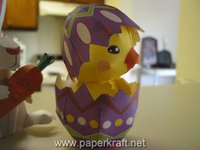



Easter Egg Papercraft [Epson HK]






Easter Egg Papercraft [Epson HK]
Easter Bunny Papercraft
Easter is the time of springtime festivals, Christians celebrate the life and resurrection of their savior Jesus Christ, and for everybody else it's a time for chocolate covered bunnies, marshmallow chicks, and lots of colorful eggs. The easter bunny is one of the best known easter symbols, so here is a paper model of an easter bunny from Epson Hong Kong, designed by Chan See Lik Paul. The paper model is in PDF format and is about 5.56MB.


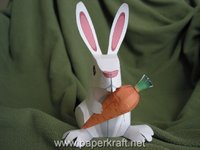


Easter Bunny Papercraft [Epson HK]





Easter Bunny Papercraft [Epson HK]
Subscribe to:
Posts (Atom)
